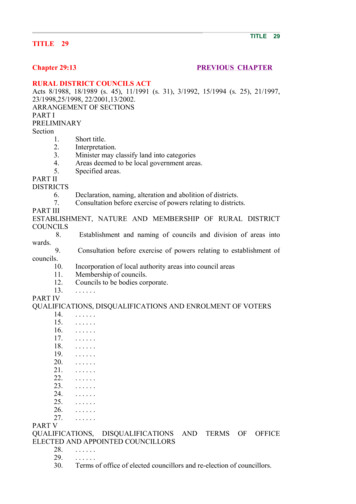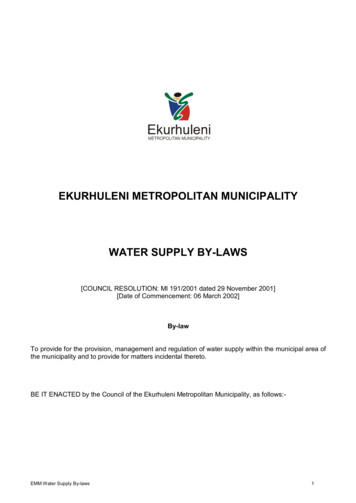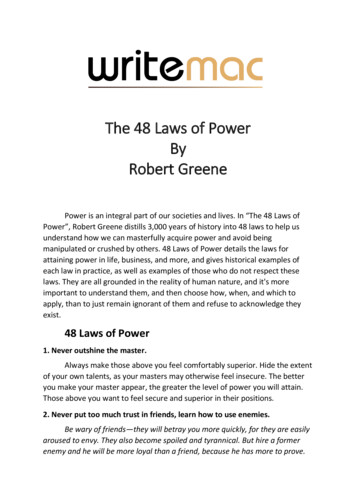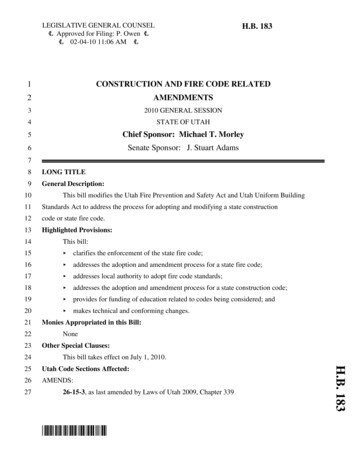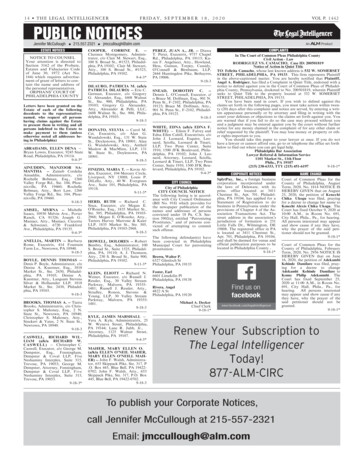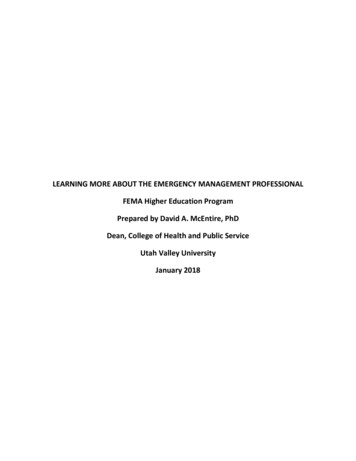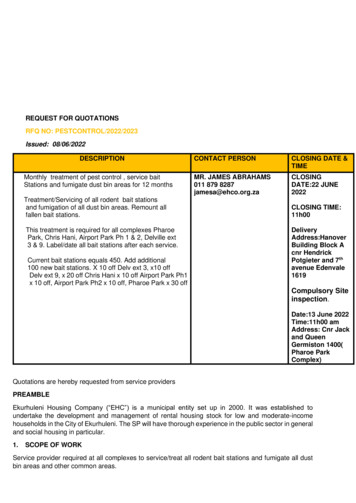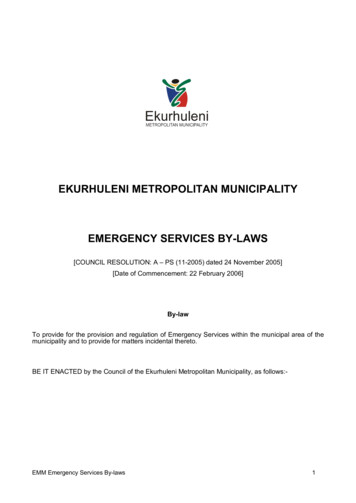
Transcription
EKURHULENI METROPOLITAN MUNICIPALITYEMERGENCY SERVICES BY LAWS[COUNCIL RESOLUTION: A – PS (11 2005) dated 24 November 2005][Date of Commencement: 22 February 2006]By lawTo provide for the provision and regulation of Emergency Services within the municipal area of themunicipality and to provide for matters incidental thereto.BE IT ENACTED by the Council of the Ekurhuleni Metropolitan Municipality, as follows: EMM Emergency Services By laws1
CONTENTSPART 11.DefinitionsPART IIADMINISTRATIVE PROVISIONS2.3.4.5.6.7.Organisation of the ServiceDriving Service vehiclesProcedure and duties during an emergency situationPretending to be a memberPowers of members and designated officersMaking Service equipment and manpower 2.PART IIIFIRE PROTECTION AND FIRE FIGHTINGCombustible materials and refuseMaking firesFirebreaksInspection of properties and instructions to occupiersAccessibility of fire fighting equipmentFire protection requirements for premisesAccess for fire fighting and rescue purposesUpkeep and maintenance of fire fighting equipmentExtractor fan systemsRational designsDumping sitesEmergency evacuation plansCertificates of fitness for all public buildingsWater supply for fire fightingRegistration applications for existing premisesPART IVDANGEROUS 38.39.40.41.42Application for approval of plansIssuing of certificates of registrationSupply of dangerous goodsExemptionsRenewal of spraying permits and/or certificates of registrationTemporary storage of dangerous goodsDelivery of dangerous goodsProhibition of certain actions"No smoking" signsFire fighting equipmentReporting of fires, accidents and dumpingSamplingStorage tanks and devices that have become obsoleteAccess to storage tanks for repairs and maintenanceInstallation, erection, removal and demolitionGroup I dangerous goodsGroup II dangerous goodsGroup III dangerous goodsInstallation of storage tankPART VCONSTRUCTION OF VEHICLES, AS WELL ASTRANSPORTATION AND TRANSPORT PERMITSService transport permitPART VIEMM Emergency Services By laws2
4344STOREROOMS FOR DANGEROUS GOODSRequirements for storeroomsKeeping and handling dangerous goods in a storeroom4546PART VIISPRAY PAINTING MATTERS AND SPRAYING PERMITSRegistration of spray painting roomsConstruction and design of spray painting roomsPART VIIIANIMALS47Handling animals during emergenciesPART IXPENALTIES48Penalties for contraventionsPART XGENERAL495051Operation of these by laws in relation to other lawsRepeal of by lawsShort titlePART XIANNEXURESAnnexure IAnnexure IIAnnexure IIIAnnexure IVAnnexure VTariffsOfficial documentsEmergency evacuation plansMaterial Safety Data Sheet Box and Emergency Evacuation Plan BoxNormative reference listEMM Emergency Services By laws3
PART IDEFINITIONS1.In these by laws, unless the context indicates otherwise "access door" means any door that provides access to an emergency route;"activity" means any work that needs to be performed to test, to service, to renew and/or to replacean extinguisher, hose reel, fire installation and/or service installation;"animal" means any animal that is kept for domestic or agricultural purposes within the area of theCouncil;"area" means any residential area or any other area within the boundaries of the Municipality;"building" includes (a)any structure, whether temporary or permanent, irrespective of the materials used in itserection, erected or used for or in connection with (i)(ii)(iii)(iv)(v)the accommodation or convenience of human beings and animals;the manufacture, processing, storage, display or sale of any goods;the provision of any service;the destruction or treatment of refuse or other waste materials; andthe cultivation of any plant or crop;(b)any wall, swimming bath, swimming pool, reservoir or bridge, or any other structureconnected with it;(c)any fuel pump or any tank used in connection with it;(d)any part of a building, including a building as defined in paragraph (a), (b) or (c); and(e)any facility or system, or part or portion of it, within or outside but incidental to a building, usedfor the provision of a water supply, drainage, sewerage, storm water discharge, electricitysupply or other similar service in respect of the building;"Building Control Officer" means the person appointed or deemed to be appointed as a buildingcontrol officer by a local authority in terms of section 5 of the National Building Regulations andBuilding Standards Act, 1977 (Act 103 of 1977);"certificate of appointment" means an identification document issued by the Chief Fire Officer to amember;"certificate of fitness" means a certificate contemplated in section 20 of these by laws, whichcertificate has been issued by the Chief Fire Officer in terms of fire related requirements to authorisesa person to occupy designated premises (which are a public building) accordingly;"certificate of registration" means a certificate issued by the Chief Fire Officer in terms of section 24of these by laws which authorises a person to occupy registered premises, or to use the premises forspray painting activities or for the storage or handling of dangerous goods, by having complied to allfire related requirements."Chief Fire Officer" means the person appointed by the Council in terms of section 5(1) of the FireBrigade Services Act, No. 99 of 1987), and includes any member who exercises any power orperforms any duty delegated by the Chief Fire Officer to the member under section 19 of the Act, andalso includes an Acting Chief Fire Officer appointed in terms of section 5(3) of the Act, and "Manager:Fire Services" has a corresponding meaning;EMM Emergency Services By laws4
"code of practice" means the code of practice as defined in section 1 of the Standards Act, 1993(Act 29 of 1993);"controlling authority" means the local authority in control of the Service as defined in the FireBrigade Services Act, 1987;"control room" means a room on any premises which is specifically designed, built and equipped tocoordinate and control an emergency situation in or on the premises in question;“Council “ means the duly constituted Ekurhuleni Metropolitan Municipality and Municipality has thesame meaning;"dangerous good" means any substance, mixture of substances, product or material that has beendeclared to be a Group I, II, III, IV, V, VI, VII, VIII or IX dangerous good in terms of section 2(1) of theHazardous Substances Act, 1973;"designated premises" means any premises designated by the Chief Fire Officer with a view to anemergency evacuation plan as contemplated in section 19 of these by laws;"device" means any vehicle, mechanical or electrical implement, electrical motor, machine,instrument, apparatus or other implement of which the whole or any part is used or is capable of beingused for, in or in connection with the manufacture, treatment, provision, delivery, supply, packaging,labelling, storage, conveyance, loading and unloading, handling, preparation, serving or administeringof any grouped dangerous good, and includes any delivery pump, filling device, spray painting deviceand mechanical hoist;"discharge" means the ignition or activation of any fireworks whatsoever;"distance to be covered" means the distance that a person would in normal circumstances have tocover to exit a room, measured from the furthest point in the room;"dump", in relation to a grouped dangerous good, means to deposit, discharge, spill or release thatsubstance (whether or not the substance in question is enclosed in a container), or to have it or permitit to be deposited, discharged, spilled or released, or to deposit, discharge, spill or release it in such away or place, or under such circumstances or for such a period, or to have it or permit it to be sodeposited, discharged, spilled or released in a manner that reasonably indicates the intention toabandon or discard the substance, and "dumping", "spilling" and "spill into" have a correspondingmeaning;"emergency" means an incident or eventuality that poses or may pose a serious threat to anyperson, environment or property, and "emergency situation" has a corresponding meaning;"emergency evacuation plan" means a written procedure and a set of detailed plans ascontemplated in Annexure III to these by laws;"emergency route" means that part of an escape route which provides the occupiers of any buildingwith protection from fire and which leads to an escape door;"escape door" means any door at the end of an emergency route, and includes any door leadingfrom the inside to the outside of a building;"escape route" means the entire path of travel, measured from an escape door to the furthest pointin any room in a building;"explosive(s)" means explosive as defined in the Explosives Act, No. 15 of 2003 and anyRegulations made under that Act(a)"extinguishing stream" means the amount of water that the Service needs to extinguish a fire;"facility" means any storage tank, whether above ground or below ground, or any transportable orEMM Emergency Services By laws5
refillable container that can be used for the keeping of dangerous goods, and includes the fuel tank ofa motor vehicle, aircraft, vessel, ship or boat;"feeder route" means that part of an escape route, which allows travel in two different directions toaccess doors of at least two emergency routes;"fire area" means the area of jurisdiction of the Council in which provision is made for fire protectionas defined in SANS 10090;"fire fighting equipment" means any portable fire extinguisher, mobile fire extinguisher, hose reel orfire hydrant;"fire grading" means, with regard to materials, components and elements used in the constructionand finishing of buildings, those materials, components and elements which have been tested andclassified in accordance with SANS 10177, Parts II to V, as amended;"fire incident" means a fire on any premises in the area;"fire installation" means any water installation, which conveys water solely for fire fighting;"fire risk category" means a fire area being divided into sub areas, which fall into one of thefollowing fire risk categories:Category A:Central business districts and extensive commercial and industrial areas normally found incities and large towns (areas where the risk to life and property are likely to be high due to fireoccurrence and spread).Category B:Limited central business districts, smaller commercial or industrial areas normally associatedwith small towns and decentralized areas of cities and large towns (areas where the risk to lifeand property is likely to be moderate due to fire occurrence and spread).Category C:Residential areas of conventional construction.Category D:Rural risks of limited buildings and remote from urban areas.Category E:Special risks. Individual risks requiring a pre determined attendance over and above thepredominant risk category in an area. Includes large shopping/entertainment centres,informal settlements, harbors, hospitals, prisons, large airport buildings, high rise buildingsand petrochemical plants.NOTE: High rise buildings, as defined in SANS 10400, are an integral part of central business districtsand would therefore be included in Category A. Buildings with major fire safety deficiencies may,however, be classed as special risks."fireworks" means explosives under Class 7, Division 2, shop goods only, as contemplated inRegulation 9.1 under the Explosives Act, 1956 (Act 26 of 1956);"grouped dangerous goods" means a group of dangerous goods as contemplated in section 1 ofthe Dangerous goods Act, 1973 (Act 15 of 1973);“ hazardous substance” means any hazardous substance contemplated in the HazardousSubstances Act, No. 15 of 1973, any regulations made under that Act.”“Hazardous Substances Act” means the Hazardous Substances Act, No 15 of 1973”“liquefied petroleum gas” means a mixture of light hydrocarbons (predominantly propane, propene,butane, butene) that is gaseous under conditions of ambient temperature and pressure and that ismaintained in a liquid state by an increase of pressure or lowering of temperature”"inspector" means a member appointed as an inspector in terms of section 2(5) of the ExplosivesAct, 2003, to control fireworks in so far as the storage, use and sale of fireworks are concerned;EMM Emergency Services By laws6
"member" means a member of the Service as contemplated in section 6 and 6A(5) of the FireBrigade Services Act, 1987;"National Building Regulations" means the National Building Regulations made in terms of section17 of the Act and to be read in conjunction with the Building Standard Act 103 of 1977 as amended;"normative reference list" means the list of SANS specifications or codes of practice, which arecontained in Annexure V to these by laws;"occupancy", in relation to any public building, means the assembly of people in or on any suchpremises "occupier" means any person who occupies or has control over any premises, ;"owner", in relation to land or premises, means the registered owner of the land or premises, andincludes any person who receives the rental or profit from the land or premises , whether for his/herown account or as an agent and, in relation to a sectional title scheme in terms of the Sectional TitlesAct, 1986 (Act 95 of 1986), for the purposes of section 18 of the Fire Brigade Services Act, 1987, thebody corporate as contemplated in the Sectional Titles Act, 1986, and, in the case of a deceased orinsolvent estate, the executor or the curator respectively;"power insulating switch" means a bipolar switch that can be activated with an L type key of whichone end is fitted with a bayonet type socket switch;"premises" means land, a building or other construction or structure, or any part of it, and includes (a)a train, boat, ship, aircraft or other vehicle, excluding, where applicable, the fuel tank of anysuch vehicle; and(b)any building or room in which explosives are stored, kept or handled"public building" means any building where people gather to view theatrical and operaticperformances, orchestral and choral recitals, and cinematographic screenings, or to attend orparticipate in indoor sports activities, including any place where people dance or practise or performany physical activity;"public place" means any path, street, walk way, side walk, park, place of rest or other place inwhich the public has authorised or unimpeded access;“ pyrotechnist” means any appropriately qualified person responsible for fireworks at fireworksdisplay”"rational design" as defined in SANS 10400;“Red Book” means Guidelines for the provision of Engineering Services and Amenities"registered premises" means any premises in respect of which a certificate of registration has beenissued,"retail dealer" means a person or concern that, for the purposes of dealing in explosives, suppliessuch explosives to any other person for use by that person and not for resale;"room" means any room or other partitioning in a building;"Service" means the Fire Brigade Service established by the Council as contemplated in section 1 ofthe Fire Brigade Services Act, 1987;“spray” means to spray, coat, plate or epoxy coat with any hazardous substance and spraying has asimilar meaning; "service installation" means any automatic extinguishing installation, fire pumpconnector, fire pump, emergency power and/or standby generator, fire detection system, fire locatingsystem, fire alarm system, emergency lighting system, emergency evacuation communication system,mechanical ventilation system, pressure regulating system, smoke ventilation system, hoists andsymbolic safety signs, and includes smoke and fire door assemblies;EMM Emergency Services By laws7
"spill into" (see the definition of "dump");"spraying permit" means a permit issued by the Chief Fire Officer in terms of section 45(1)(a) ofthese by laws;"spraying room" means any room, building or structure that is designed, built, equipped or erectedsolely for spraying or coating vehicles, parts of vehicles, or any other objects with Group III dangerousgoods and/or combinations of Group III dangerous goods, or with any other substance, to form adecorative and/or corrosion resistant layer, or for any purpose incidental thereto, and "spraying booth"and "submersion tank", as well as any related process involving electrolysis, have a correspondingmeaning;"storeroom" means a room, which is constructed, equipped and maintained as contemplated insection 43 of these by laws;"storey" means that part of a building, which is situated between the top of any floor and the top ofthe floor above it or, if there is no floor above it, that portion between such floor and the ceiling aboveit (any mezzanine floor, open work floor, catwalk or gallery is regarded as part of the storey in which itis situated): Provided that, in relation to a building (a)(b)(c)(d)the ground storey will be regarded as the storey in which there is an entrance to the buildingfrom the level of the adjoining ground or, if there is more than one such storey, the lower orlowest of these storeys;a basement will be regarded as any part of the building, which is below the level of the groundstorey;an upper storey will be regarded as any storey of the building which is above the level of theground storey; andthe height, expressed in storeys, will be regarded as that number of storeys which includes allstoreys other than a basement;"temporary structure" means any structure that is apparently temporary in nature;"vehicle" includes a semi trailer or trailer which has at least four wheels with independent axles andsuspension systems and can be hitched to a truck tractor, or any other motor vehicle as contemplatedin the National Road Traffic Act, 1996 (Act 93 of 1996),;"wholesale dealer" means a person or concern that, for the purposes of trade, supplies explosives toany other dealer for resale.PART IIADMINISTRATIVE PROVISIONSORGANISATION OF THE SERVICE2.(1)(2)The Council has established a Fire Brigade Service as contemplated in terms Section 3 of theFire Brigade Services Act, 1987, as amended,The Council must maintain the Service within its area, which includes(a) the appointment of a Chief Fire Officer and the necessary members of the Service(b) ensuring that the members and other personnel are properly trained;(c)acquisition of vehicles, machinery, equipment, devices and accessories to ensure thatthe Service is effective and able to attain its objectives being:(i)(ii)(iii)(iv)(v)(vi)preventing the outbreak or spread of a fire;fighting or extinguishing a fire;the protection of life or property against a fire or other threatening danger;the rescue of life or property from a fire or other threatening danger;the provision of an ambulance service;the performance of any other function connected with any of the matters referred to insubsection (1)(a) to (e).EMM Emergency Services By laws8
(3)(4)(a)The Chief Fire Officer is in charge of the Service.(b)Whenever the Chief Fire Officer is for any reason unable to perform his/her duties ofoffice, the Council will appoint a member as Acting Chief Fire Officer to perform theduties and functions of the Chief Fire Officer.The Council may, in terms of an agreement as contemplated in section 12 of the Fire BrigadeServices Act, 1987, employ its Service within or outside its area of jurisdiction, or within oroutside the Province of Gauteng, against payment of the tariffs determined in Annexure I tothese by laws, or against payment in terms of or on the conditions contained in the agreementconcerned.DRIVING SERVICE VEHICLES3.(1)Any member may, with the written authority of the Chief Fire Officer, drive a Service vehicle ifhe/she has the applicable driving licence for the vehicle in question as required by theNational Road Traffic Act, 1996.(2)A member who is duly authorised to do so, as contemplated in subsection (1), must drive aService vehicle in accordance with the National Road Traffic Act, 1996, and any regulationsmade under the Act.PROCEDURE AND DUTIES DURING AN EMERGENCY SITUATION4.(1)(2)(3)The Chief Fire Officer or a member who is in charge of an emergency situation must ensurethat (a)adequate manpower and the appropriate apparatus and equipment are madeavailable and are used without delay;(b)the emergency situation is assessed and that additional equipment and/or assistanceis sent for without delay, where applicable, as agreed upon in and subject to theagreement as referred to in section 2(3) of these by laws; and(c)all pertinent information, including information about places and times and relevantparticulars, is recorded during the emergency situation or as soon as possiblethereafter, and that the recorded information is preserved in accordance with theprovisions of the National Archives of South Africa Act, 1996 (Act 43 of 1996), andany regulations made under the Act.All persons and/or bodies, including any State department as contemplated in section 17 ofthe Fire Brigade Services Act, 1987, the South African Police Service and the Department ofJustice, who wish to inspect any information referred to in subsection (1)(c) must send awritten application to the Chief Fire Officer, accompanied by the fees prescribed in Annexure Ito these by laws, together with an appropriate substantiation as to why the information isrequired.Any press release concerning emergency situations or any matter connected with anemergency situation must be in accordance with the policy guidelines determined by theCouncil.PRETENDING TO BE A MEMBER5.(1)No person, except a member, may wear any official clothing, uniform, badge or insignia of theService;(2)No person may pretend to be a member of the Service;(3)Any person who represents himself/herself as a member must identify himself/herself byproducing the relevant certificate of appointment and/or mark of appointment, or by furnishingproof of identity within a reasonable period.EMM Emergency Services By laws9
POWERS OF MEMBERS AND DESIGNATED OFFICERS6.(1)Every member, of the Service, has all the powers provided for in the Fire Brigade ServicesAct, 1987.(2)A designated officer as contemplated in 6(4)(a) may (a)seize any certificate of fitness, certificate of registration or spraying permit providedfor in these by laws if the conditions of or endorsements in the document are notbeing complied with, or if the member has reasonable grounds to suspect thatunauthorised changes have been made to the document;(b)institute the relevant prosecution in connection with subsection (2)(a) or have theprosecution instituted, as the case may be; and(c)seize anything (hereinafter called "object") on any premises connected with aspraying permit, certificate of registration or certificate of fitness, but must providereasonable proof of a contravention of any condition of or endorsement in such permitor certificate and must remove the object or have the object removed to a place ofsafe custody: Provided that the seizure does not exempt any person from any otherrelevant provisions of these by laws: Provided further that the seizure is, subject tosection 20 of the Fire Brigade Services Act, 1987, made in accordance with thefollowing conditions:(i)The Chief Fire Officer or the delegated member must grant prior approval inwriting for the seizure.(ii)Official proof of seizure must be issued to the person from whom the objecthas been seized, together with a description of the object.(iii)After an order issued in terms of the Fire Brigade Services Act, 1987, orthese by laws has been complied with in full or after a prosecution in terms ofsection 21 of the Fire Brigade Services Act, 1987, has been instituted andfinalised, as the case may be, any object seized must be returned to theperson from whose possession it was taken subject to any order of court.(3)Any member may seal off any building or premises by temporarily closing a street, passage orplace which he/she deems necessary for public safety or for effectively fighting a fire ordealing with any other emergency that may give rise to a fire, explosion or other threat to lifeor limb, and the member may remove, using no more force than is reasonably necessary, anyperson who refuses to leave the street, passage or place after having been requested by themember to do so.(4)(a)Designated officers must be –(i)(b)suitably trained and certified as peace officers and be appointed as such interms of Government Notice R159 of 2 February 1979, as amended;All designated officers have the power (i)in terms of the provisions of section 56, read with section 57, of the CriminalProcedure Act, 1977 (Act 51 of 1977), to issue summons involving a spotfine;(ii)in terms of the provisions of section 341 of the Criminal Procedure Act, 1977,to issue spot fines for certain minor offences;(iii)in terms of the provisions of section 44 of the Criminal Procedure Act, 1977,to issue a warrant of arrest;EMM Emergency Services By laws10
(iv)in terms of the provisions of section 41 of the Criminal Procedure Act, 1977,to ask certain persons for their names and addresses and to arrest personswithout a warrant if duly authorised to do so; and(v)in terms of the provisions of section 54 of the Criminal Procedure Act, 1977,to serve summons in order to secure the attendance of the accused in amagistrate's court.MAKING SERVICE EQUIPMENT AND MANPOWER AVAILABLE7.(1)With the approval of the Chief Fire Officer, the Service may, at the request of any body orperson and at the tariffs determined in Annexure I to these by laws, use any equipmentand/or manpower at its disposal to provide any special service in connection with the aims ofthe Service.(2)The said equipment and/or manpower may be withdrawn summarily if the equipment and/ormanpower are required elsewhere for or in connection with an emergency situation.PART IIIFIRE PROTECTION AND FIRE FIGHTINGCOMBUSTIBLE MATERIALS AND REFUSE8.(1)No person may store any combustible materials of whatever nature, or have them stored orpermit them to be stored in such a manner and in such a position as to likely pose a firehazard to any human being, animal, building or premises.(2)No person may allow grass, weeds, reeds, shrubs, trees or any like vegetation to becomeovergrown on premises to such an extent that it may pose a fire hazard or a probable firehazard to any adjacent premises and/or any other person's property.MAKING FIRES9.10.(1)No person may, subject to provision of the Veld and Forest Fire Act 1989 (Act 101 of 1998)and Environmental Management Act, 1989 (Act 73 of 1989) within the area, make an open,uncontrollable or unattended fire or permit a fire to be made in such a place and/or in such amanner as to pose a real or potentially real threat to any human being, animal, building,premises or other property: Provided that this prohibition is not applicable to (a)a fire in an approved, purpose made stove, fireplace or hearth, which is an integralpart of a structure;(b)a fire for preparing food on private premises or premises set aside for that purpose;and(c)a device for preparing food, which device is heated by means of electricity or liquidpetroleum gas and is positioned in such a way that the device poses no threat to lifeor property on any premises.(2)No person may, without the written authority of the Chief Fire Officer, burn any refuse, wood,straw or other combustible materials within the area, or have them burnt or permit them to beburnt within the area, unless the refuse, wood, straw or other combustible materials are burntinside an approved purpose made incinerator or incinerating device, subject to the provisionsof subsection (1).FIREBREAKS(1)The owner or occupier of premises in the area may not permit the premises to be or becomeovergrown with grass, weeds, reeds, shrubs and trees to the extent that the grass, weeds,reeds, shrubs and trees may pose a real or potentially real fire hazard to any adjoiningpremises or other premises or property.EMM Emergency Services By laws11
(2)The owner or occupier of (a)(b)(3)an erf, site, stand or premises situated within a proclaimed township in the area mustremove the fire hazard or ensure that the fire hazard is removed by (i)cutting to a maximum height of 150 mm above ground level any grass, reedsand/or weeds that may reasonably be connected with the fire hazard;(ii)cutting around any shrubs and/or trees, which may be standing in the areabeing cut;(iii)pruning, chopping down or sawing off such shrubs and/or trees, as the casemay be; and(iv)removing all chopped and/or sawn off residue from the erf or premises orensuring that the residue is removed; andan agricultural holding or farm situated in the area must reduce the potential firehazard by physically clearing a safety fire belt, at least 5 m wide (measured parallelfrom each boundary line which borders the premises to the inside of the premises) sothat no vegetation or residue whatsoever remains on this belt, and the owner oroccupier must at all times maintain the belt or ensure that the belt is maintained insuch condition: Provided that where obstructions occur within the 5 m belt, a 5 m beltis also maintained around those obstructions.Notwithstanding the above, the provisions of the National Veld and Forest Fire Act, No. 101 of1998 apply mutatis mutandis to the application of this section.INSPECTION OF PROPERTIES AND INSTRUCTIONS TO OCCUPIERS11.(1)Any officer contemplated in section 6(4) of these by laws may, in executing all powersdelegated in terms of relevant and applicable legislation, enter any premises at anyreasonable time to conduct inspections to determine whether there is any fire, dangerousgoods or other hazard on the premises.(2)An officer contemplated in subsection (1) may, arising from a condition referred to insubsection (1), serve on the occupier of the premises or any other premises a writteninstruction and fire protection directives and requirements necessary to rectify the conditionon or in the prem
EMM Emergency Services By laws 2 CONTENTS PART 1 1. Definitions PART II ADMINISTRATIVE PROVISIONS 2. Organisation of the Service 3. Driving Service vehicles 4. Procedure and duties during an emergency situation 5. Pretending to be a member 6. Powers of members and designated officers 7.

